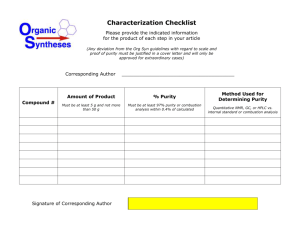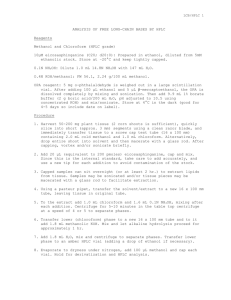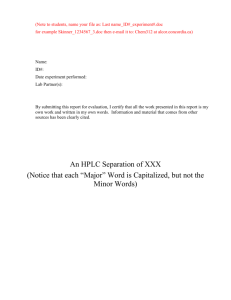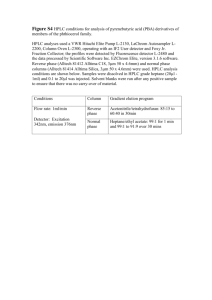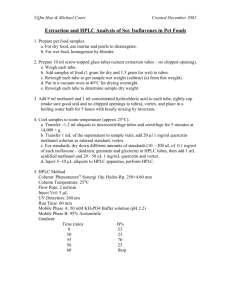Actinometer Solutions and Detection
advertisement
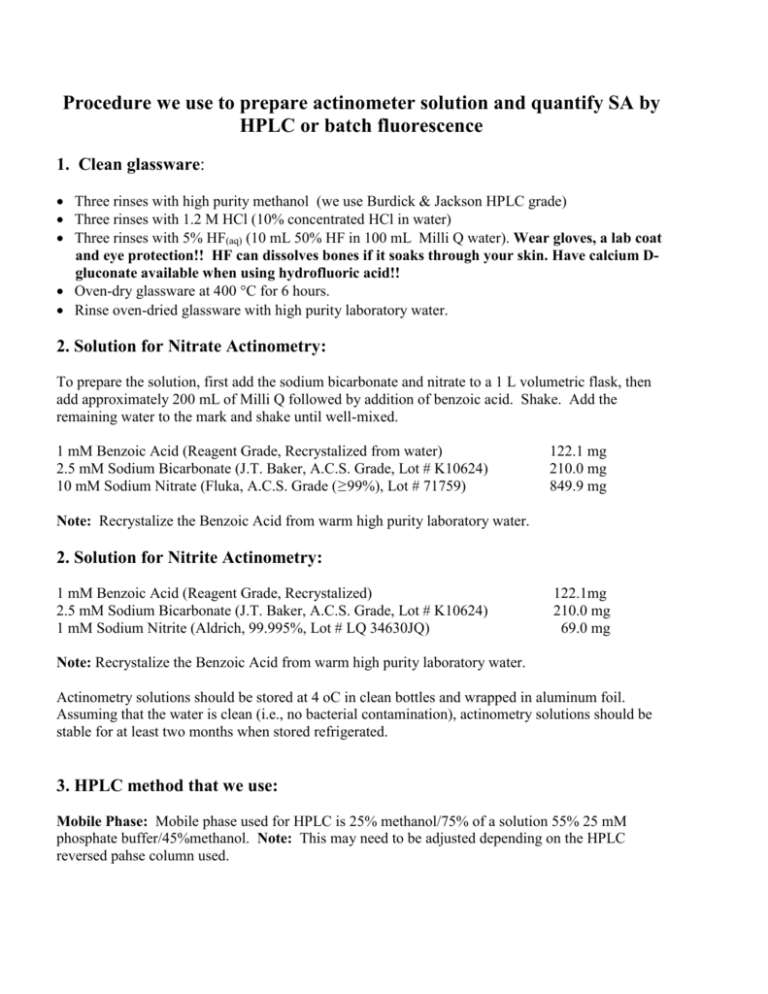
Procedure we use to prepare actinometer solution and quantify SA by HPLC or batch fluorescence 1. Clean glassware: Three rinses with high purity methanol (we use Burdick & Jackson HPLC grade) Three rinses with 1.2 M HCl (10% concentrated HCl in water) Three rinses with 5% HF(aq) (10 mL 50% HF in 100 mL Milli Q water). Wear gloves, a lab coat and eye protection!! HF can dissolves bones if it soaks through your skin. Have calcium Dgluconate available when using hydrofluoric acid!! Oven-dry glassware at 400 °C for 6 hours. Rinse oven-dried glassware with high purity laboratory water. 2. Solution for Nitrate Actinometry: To prepare the solution, first add the sodium bicarbonate and nitrate to a 1 L volumetric flask, then add approximately 200 mL of Milli Q followed by addition of benzoic acid. Shake. Add the remaining water to the mark and shake until well-mixed. 1 mM Benzoic Acid (Reagent Grade, Recrystalized from water) 2.5 mM Sodium Bicarbonate (J.T. Baker, A.C.S. Grade, Lot # K10624) 10 mM Sodium Nitrate (Fluka, A.C.S. Grade (≥99%), Lot # 71759) 122.1 mg 210.0 mg 849.9 mg Note: Recrystalize the Benzoic Acid from warm high purity laboratory water. 2. Solution for Nitrite Actinometry: 1 mM Benzoic Acid (Reagent Grade, Recrystalized) 2.5 mM Sodium Bicarbonate (J.T. Baker, A.C.S. Grade, Lot # K10624) 1 mM Sodium Nitrite (Aldrich, 99.995%, Lot # LQ 34630JQ) 122.1mg 210.0 mg 69.0 mg Note: Recrystalize the Benzoic Acid from warm high purity laboratory water. Actinometry solutions should be stored at 4 oC in clean bottles and wrapped in aluminum foil. Assuming that the water is clean (i.e., no bacterial contamination), actinometry solutions should be stable for at least two months when stored refrigerated. 3. HPLC method that we use: Mobile Phase: Mobile phase used for HPLC is 25% methanol/75% of a solution 55% 25 mM phosphate buffer/45%methanol. Note: This may need to be adjusted depending on the HPLC reversed pahse column used. The 25 mM phosphate is prepared by adding 3.4 mL of concentrated phosphoric acid (85% phosphoric acid in water, Fisher, A.C.S. Grade, Lot # 001143) to 2 L of Milli Q water (high purity laboratory water prepared from a Milli Q system, Millipore Corporation). The 55% phosphate buffer/45%methanol is prepared by combining 550 mL of the 25 mM phosphate solution and 450 mL methanol in a 1 L graduated cylinder. 0.2 m-filter the mobile phase. Injection Loop: 100 L. For high [SA] (e.g., 1 M) use a smaller loop (e.g., 10 L). Column: Waters 8 x 100 mm Radial Pak cartridge w/ 4 m diameter C18 packing. Detector: 1050-F Hitachi Fluorescence detector, 305 ± 7.5 nm excitation, 410 ± 7.5 nm emission. Flow Rate: ~1.2 mL min-1 Notes: The unexposed actinometry solution SA peak area is subtracted from light-exposed sample peak areas. Salicylic acid standards are made by adding uL quantities of a SA standard to mL volumes of the actinometry solution. If a different HPLC system is used, the mobile pahse composition will likely need to be adjusted. 4. The batch fluorescence method that we use: Place the light-exposed actinometry sample (or dark control) into a 1 cm quartz fluorescence cell and place this into the fluorometer, nominally set at an excitation wavelength of 305 nm and an emission wavelength of 410 nm. Take the reading of samples, blanks and standards. Calculate sample SA concentrations from the standard regression line after subtracting the blank response. For batch fluorescence, we have used an ISS PC1 fluorometer (ISS Corp.) or a FluoroMax fluorometer (HORIBA Jobin Yvon Corp.), but most fluorometers should work well. Note: Be careful when you do batch fluorescence that you don’t leave the sample exposed to excitation radiation in the fluorometer because this will result in further production of SA; this should be tested for the fluorometer that is used. The detection limit of the batch fluorescence technique is not as good as the HPLC technique, owing to fluorescence interferences present in the batch technique (i.e., a higher blank) that are separated out in the HPLC technique. Therefore, do not use the batch technique when very low light doses are expected—such as may be encountered at 20 m deep in the water column during a day-long deployment.



